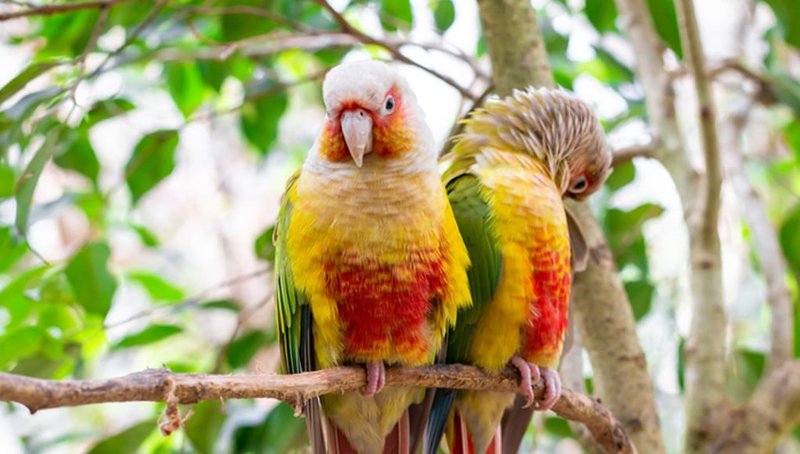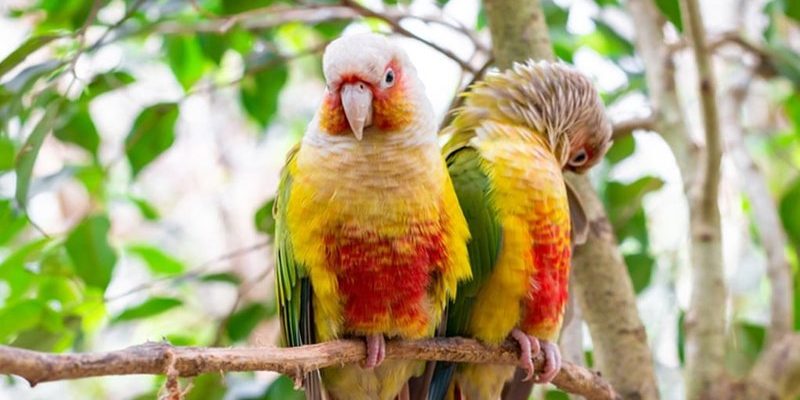
Conures belong to a group of small to medium-sized parrots native to Central and South America. There are various types of conures, each with its unique colors and behaviors. Whether you’re out on a hike or just wandering through a park, knowing how to identify a conure can make your outdoor adventures even more exciting. Let’s break down the key features and behaviors that can help you recognize these lively little birds in the wild.
Physical Characteristics of Conures
To start, let’s talk about the physical traits that make conures stand out. One of the first things you’ll notice is their coloration. Conures are known for their vibrant feathers, which can range from bright greens to golden yellows, fiery oranges, and even deep blues. For instance, the Sun Conure flaunts bright yellow and orange feathers, while the Green-cheeked Conure wears a more subdued blend of green with touches of maroon.
Size is another telltale sign. Most conures are not too large, typically measuring around 10 to 12 inches in length. When you see a parrot-sized bird with a short tail but a plump body, there’s a good chance it could be a conure. They have a distinctively round head and a relatively short, hooked beak perfect for cracking seeds.
You might also notice their distinctive flight pattern. Conures have a zig-zag flight style, darting quickly from one branch to another as they hop around in flocks. This energetic behavior is a vital clue in spotting them, especially if you hear their loud, playful calls before you see them.
Sounds and Calls of Conures
Speaking of calls, let’s dive into the sounds that conures make. These birds are quite vocal, and their calls can be one of the easiest ways to identify them in the wild. Conures often communicate with a series of screeches, whistles, and chattering sounds. For example, the Blue-crowned Conure has a unique, sharp whistle that can catch your ear from a distance.
You might be wondering, “Why are they so loud?” Well, conures are social creatures that live in flocks, and being vocal helps them stay connected with their group. If you hear a cacophony of playful sounds that seem to echo through the trees, it’s likely a group of conures engaging in their usual chatter.
Listening for their calls can guide you to their location, but keep in mind that their sounds can also blend into the natural ambiance of the environment. So, if you hear lively chirps and whistles but can’t see the birds right away, don’t get discouraged. Stay patient, and you might just catch a glimpse of them!
Habitat and Behavior
Now, let’s talk about where to spot conures. Understanding their habitat is crucial for finding them in the wild. These birds typically prefer tropical and subtropical environments, often inhabiting forests, woodlands, and even savannas. They are commonly seen in areas with plenty of trees, where they can find food and nesting sites.
Conures are social animals, often seen in flocks that can range from just a few birds to dozens. Watching their group behavior can be quite entertaining. They enjoy playing and interacting with one another, which can make them easier to spot amidst the foliage. Keep an eye out for them foraging for seeds and fruits or engaging in playful displays with their flockmates.
When searching for conures, look for movement. Their energetic nature means they’re often hopping around and showing off their playful side. If you spot a flash of color or hear lively chatter, it’s worth investigating further to see if you’ve found a flock of these charming parrots.
Feeding Habits of Conures
Understanding what conures eat can also help in identifying them. They enjoy a diet that consists mainly of seeds, fruits, and nuts. In the wild, they often forage among the trees, searching for ripe fruits or hidden seeds. If you see birds pecking at the ground or nibbling on tree branches, they might just be conures having a snack.
Common foods that attract conures include berries, mangoes, and sunflower seeds. If you’ve stumbled upon an area with many fruiting trees, keep your eyes peeled—the chances of spotting conures munching away are pretty high. Their love for food drives a lot of their activity, so watch for their playful antics while they feast.
If you’re in a place where conures are known to visit, consider bringing some seeds or fruits with you. Just ensure you’re following local wildlife guidelines when it comes to feeding wild birds. Not only can it make for an unforgettable experience, but it can also increase your chances of encountering a conure.
Conure Species and Their Unique Traits
As you become more adept at spotting conures, you might encounter different species, each with its unique characteristics. Here are a few notable ones:
- Sun Conure: These birds are popular for their vibrant yellow and orange plumage. They are often loud and social, making them a delight to watch.
- Green-cheeked Conure: A smaller species, these birds have a more subtle mix of greens and maroons, often making them blend in with the trees.
- Blue-crowned Conure: Recognizable by their blue crown and green body, these conures are known for their playful behavior and unique calls.
- White-eye Conure: These birds have distinctive white eye-rings and are often found in flocks in the wild, making them an exciting find.
When you can identify these unique traits, you’ll not only enjoy spotting conures but also learning about their behaviors and personalities. Each species adds its own flair to the vibrant world of avian life.
Conservation and Respecting Wildlife
With the joy of spotting conures comes the responsibility of respecting their environment. Sadly, many conure habitats are threatened by deforestation and urbanization. If you’re out observing these beautiful birds, always keep in mind the importance of leaving no trace. Stay on established trails, avoid feeding them human food, and never disturb their nests.
You might be asking, “What can I do to help?” One great way to contribute is by supporting local conservation efforts and organizations that protect their habitats. Understanding this context adds another layer to your experience when observing wildlife. You’re not just a spectator; you’re part of a larger picture of preserving the beauty of nature.
As you become more familiar with identifying conures, take a moment to appreciate their role in the ecosystem. These lively little birds not only bring color to our surroundings but also play a part in pollination and seed dispersal, which helps the environment thrive.
Planning Your Adventure
Finally, if you’re excited to head out and look for conures, planning your adventure is key. Consider researching local parks or natural reserves known for their birdlife. Bring along a good pair of binoculars to get a closer look without disturbing them. Ensure you have a field guide or a birding app on hand to help you identify species quickly, even on the go.
Timing matters too. Early morning or late afternoon is often when birds are most active, so plan your outings accordingly. And don’t forget to enjoy the experience! Part of the fun of spotting conures—or any wildlife—is soaking in the sights, sounds, and sensations of nature around you.
In conclusion, identifying a conure in the wild is a delightful challenge that brings you closer to nature. With some knowledge of their physical traits, sounds, and behaviors, you’ll be well on your way to spotting these vibrant parrots. Remember to enjoy every moment in the great outdoors and take care of the environments you’re exploring. Happy birdwatching!

